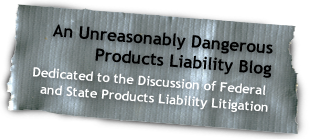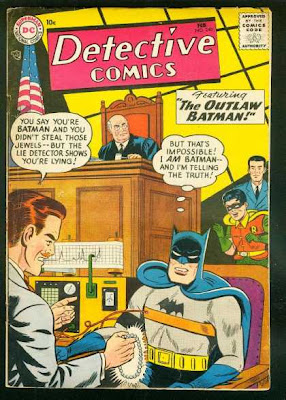Today, Abnormal Use continues its series, “Abnormal Interviews,” in which this site will conduct brief interviews with law professors, practitioners and other commentators in the field. For the third installment, we turn to law professor Mary J. Davis of the University of Kentucky College of Law. A products liability professor, she co-authored the products liability treatise, Owen, Madden and Davis on Products Liability. The interview is as follows:
1. What do you think is the most significant new development in products liability of the last year?
I think that the whole question of preemption continues to be the most significant new development in products liability in the last two decades and every time the Court decides a question, it is a significant new development. For example, when the Court found no implied preemption in the pharmaceutical labeling case, Wyeth v. Levine, in late 2009, that was a huge development given that the Court had been forecast to be friendly to preemption in that case and it was not. And now the Court is poised to answer another preemption case, Bruesewitz v. Wyeth, involving express preemption under the National Childhood Vaccine Injury Compensation Act. Any time the Court decides a preemption case, it’s a significant new development. Other than that, I think the Consumer Products Safety Improvements Act implementation is significant if only because the changes made in 2008 by the statute reflect a substantial re-focus on regulating product safety from the federal regulatory side.
2. What rule or concept in modern products liability jurisprudence is the most outdated? How would you change it and why?
No or limited liability for successor corporations. Come on. You shouldn’t be able to sell your company to get out from under liability that can be established under applicable law at the time of the product’s sale no matter how much it might make business sense to try to avoid that liability. I would expand the product line exception so that if the company continues to sell the product, or any variant, liability will continue to apply to products sold by the predecessor.
3. Generally, how would you characterize the media coverage of products liability?
Extremely weak. I think top journalists do a good job; I have read good material in The New York Times, Wall Street Journal and Washington Post on the Toyota recall and litigation frenzy, for example. Generally, though, I think the media does not try to understand even the basic features of products liability, much less the nuances. I would like to see more time/pages devoted to explaining products liability law and the litigation system. The public needs it. I am personally often reluctant to talk to the press, however, and, when I do, the most ridiculous, out-of-context information comes through. It is difficult to use the media to give a civics lesson, but the media should be more interested in clarifying the public’s understanding of the legal system than it appears to be.
4. What advice would you give to lawyers practicing products liability in 2010. What should they be looking out for?
I have not practiced since 1991, so I should be asking your readers what advice they would give me in training lawyers who might practice products liability in 2010. I hope some of them will take me up on that. I would say, however, that lawyers who practice in federal court must understand Iqbal, the Supreme Court case that changes the face of pleading under the Federal Rules. Of course, state pleading requirements are not affected.
5. What federal or state court opinion has been the biggest surprise for you of late and why?
That’s a tough one because I just told you that I was surprised by Wyeth v. Levine, the pharmaceutical preemption case. I was also extremely surprised when the Supreme Court decided Altria Group, Inc. v. Good, which found that consumer fraud litigation against the tobacco companies was not preempted. Since the first tobacco litigation preemption case in 1992, Cipollone v. Liggett Group, the Court had gravitated toward a strict/text-based express preemption analysis advocated by Justice Scalia in dissent in Cipollone and subsequent cases, most recently Riegel v. Medtronic, Inc., a medical device preemption case. Many observers anticipated that perhaps Justice Scalia’s approach would prevail in Altria Group. It did not. The decision indicates a trend in favor of a more flexible approach to the search for congressional intent to preempt which the Court had employed before Cipollone. I suppose you can tell that I am a follower of the preemption cases. They are the single most important development in products liability since I have been involved in the field, as a litigator for 6 years and now as a professor for 19.
BONUS QUESTION: What do you believe is the most interesting depiction of a products liability lawsuit in popular culture?
I liked the movie about the whistleblower in the tobacco litigation, Jeffrey Wigand, even though I think it’s unfortunate that the only products liability movies are [those] about the allegedly unsavory actions of corporate defendants. I always thought that most products liability defendants didn’t deserve that reputation.
BIOGRAPHY: Mary J. Davis is the Stites and Harbison Professor of Law at the University of Kentucky College of Law. Her research focuses on products liability law. She joined UK Law in 1991 after six years of a litigation defense practice, predominantly in products liability, for the law firms of Womble, Carlyle, Sandridge & Rice in Winston-Salem, North Carolina and McGuire, Woods, Battle, & Boothe in Richmond, Virginia. She is co-author of the textbook Products Liability and Safety: Cases and Materials (6th ed. 2010) (including the annual case supplement and Teacher’s Manual) with Professors David Owen and John Montgomery of the University of South Carolina School of Law. She is also a co-author of a multi-volume products liability treatise, Owen, Madden and Davis on Products Liability. Professor Davis is a 1985 magna cum laude graduate of the Wake Forest University School of Law and a 1979 cum laude graduate of the University of Virginia. She is also a member of the American Law Institute since 2001 where she serves on the Members Consultative Groups for the Restatement (Third) of Torts, Products Liability, and Aggregate Litigation Projects.
















